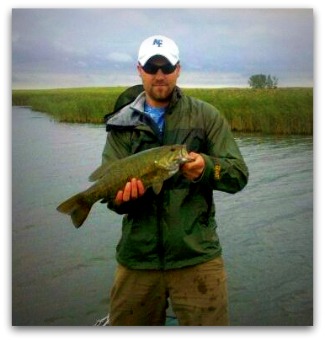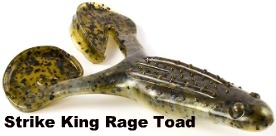Buzz Frog Fishing 101
By Eric Ehn
A buzz frog is a soft plastic topwater lure with a frog shaped body and legs designed to churn the water behind it. It is very similar to a buzzbait, but with a different profile, vibration, and sound. Primarily it is used to create a reactionary strike out of bass or other predatory fish. This technique can produce fish from the time bass instinctively migrate to shallow water spawning areas through the time they binge eat in preparation for winter. It is an effective way to make large fish move from their haunts and chase after your bait. Not to mention watching mean bass destroy your topwater bait is truly one of the most exciting and addicting ways to fish.
through the time they binge eat in preparation for winter. It is an effective way to make large fish move from their haunts and chase after your bait. Not to mention watching mean bass destroy your topwater bait is truly one of the most exciting and addicting ways to fish.
Equipment
To properly fish a buzz frog you will want to use a baitcast reel. The main reason for this is that a baitcast reel generally has a faster transition from cast to retrieve, keeping the frog on top of the water and in the strike zone for a longer period. Rods should be 6'6" or longer and have at a minimum a rating of medium heavy power. A Longer, more powerful, rod will give you the leverage you need to pull the fish away from whatever cover or structure you are fishing. Never use fluorocarbon line with this technique. Fluorocarbon sinks and will ruin the action of your frog, reducing the number of strikes you get. 20 lb, or stronger, braided line is a great choice because it will allow the frog to ride the top of the water better and its lack of stretch will allow for positive long range hook sets. If you find that the bass are having a hard time eating the frog switching to a rod with monofilament will let the bass get a better hold of the bait; due to mono's stretching properties. Having the right rod, reel, and line combination can be the difference between a live well full of round stomachs and watching the bass steal, spit, launch, and ignore your bait.
The frog to use is any frog you have confidence in. The Strike King Rage Toad and Yum Money Frog are two great frogs that run belly down fairly well. The Money Frog has a wide stance with legs pitch in and creates the most commotion of any frog on the market. The Rage Toad has a gurgling sound that bass seem to find particularly  attractive and they come embedded with Strike Kings coffee flavor. It is also the only frog where you can trim the legs to create more or less action depending on what the bass prefer. Still any brand of frog that you have success with and confidence in should be on the end of your rod. Always rig these frogs with a wide gap hook. To effectively snare the fish the hook needs to penetrate the frog's body and the fish's tissue. If you have too shallow of a gap on the hook, the frog's body will stop the hook point from connecting with the fish's mouth. Hooks with a weight on the shank allow the bait to run truer and can increase hook ups by falling into the bass' mouth during the strike. Rigging a hook with a weight on the shank is somewhat difficult though and if your frog is ripped off the hook you must re-tie to add a new body, so the benefits of the weight may not be worth the extra work for you.
attractive and they come embedded with Strike Kings coffee flavor. It is also the only frog where you can trim the legs to create more or less action depending on what the bass prefer. Still any brand of frog that you have success with and confidence in should be on the end of your rod. Always rig these frogs with a wide gap hook. To effectively snare the fish the hook needs to penetrate the frog's body and the fish's tissue. If you have too shallow of a gap on the hook, the frog's body will stop the hook point from connecting with the fish's mouth. Hooks with a weight on the shank allow the bait to run truer and can increase hook ups by falling into the bass' mouth during the strike. Rigging a hook with a weight on the shank is somewhat difficult though and if your frog is ripped off the hook you must re-tie to add a new body, so the benefits of the weight may not be worth the extra work for you.
Color choice on these baits is pretty simple. Carry a white, a black, and a leopard frog in your tackle box and you should be able to cover 98% of your fishing situations. Before you get on the water browse around the launch area or wherever you're fishing to see if you can find a frog to model your selection after. If you don't have a model then just try to match bright conditions or clear water with light color frogs, and dark conditions and muddy water with darker colored frogs. If you still cannot decide start with a leopard frog color and see what the fish like. If you find a combination that is earning strikes, but the fish aren't eating the frog, first try changing colors then styles if that doesn't work. Sometimes it can be subtle changes that prove to be the most effective. Also, there are literally hundreds of color combinations out there so feel free to experiment if you think a certain color may increase your strikes.
Technique
Normally strikes will occur in predictable areas where a bass can trap the frog against, or between, structure and cover. This predictability comes from the bass' nature. If a morsel of food lands itself in a spot on the water where it has few escape options, it's essentially trapped, a bass will react, without thinking, and attack. These zones are the areas you're trying to put you bait in. Areas on a lake to target are along vertical structure and various types of cover. Vertical structure can be pilings, dock posts, chunk rocks, emergent vegetation, and anything that creates a 45 degree angle or larger with the surface of the water. Cover that should be targeted can be lay down trees, weed edges, shady areas, stump fields, or any relatively shallow area where bass can hide and ambush. While all of these areas contain bass, to get them to attack a buzz frog you will need to find the choke point; an area where the bass can easily trap the frog and earn an easy meal. Normally these choke points will be where structure and cover overlap. One lay down tree is a good spot, but pulling the frog between two, or between a dock and a row of bull rushes will greatly increase the number of fish you catch. The key to these areas is identifying the best choke point, casting beyond it by a couple of feet, and churning the bait through the premier window. Finding these kill zones are the crux of buzz frog fishing and a skill that must be learned.
Many times it is not easy to cast to these areas. It can require skipping under tree limbs, sliding the bait and your line between blades of thick grass, and any number of contortionist casts to get the frog into just the right position. Obviously, having placed the frog in harm's way under a tree and next to a bolder requires confidence in your equipment and practice to get fish back to the boat. Once the bait hits the water a steady retrieve through the strike zone is all it takes to get the bass to lunge at your bait. Vary your retrieve speed until you find the rate that the fish prefer, but minuet changes in weather, temperature, and wind can change the rate you need. If a fish misses the bait continue your retrieve because many times a bass will attempt a second and even third time. And if on your next cast the fish doesn't expose itself reel in and throw a sinking soft plastic to where the strike occurred. Many bass will sit on that spot and wait for pieces of the escaped frog to sink down for a meal.
Once a strike occurs you will be surprised by the intensity it can inspire you. It is difficult to do, but waiting to set the hook will help land more fish. Watch your line closely and you will actually be able to tell if the fish has a hold of it or not. The line will slide sideways through the water and that is your cue to set the hook and set it hard. Setting to early will merely pull the frog away from the bass, who will be left wondering where his meal went.
Buzz Frog Fun
Fishing a buzz frog is as exciting as fishing can get and can be as productive as any other techniques when bass are shallow. As fish see more and more hard body topwater lures this year, try switching to this soft plastic and see if you can conjure some giant fish out of your favorite lake.
Eric Ehn
Badlands Bass Bandits Member




